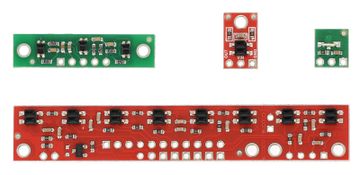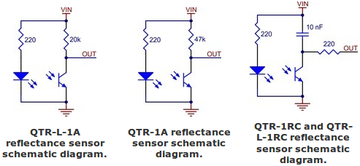Différences entre versions de « Pololu-Senseur-QTR »
| Ligne 1 : | Ligne 1 : | ||
{{Pololu-Senseur-QTR-NAV}} | {{Pololu-Senseur-QTR-NAV}} | ||
{{infobox tuto | {{infobox tuto | ||
| − | | image = Pololu-Senseur-QTR-01. | + | | image = Pololu-Senseur-QTR-01.jpg |
| title = Guide utilisateur du senseur QTR (senseur de ligne) | | title = Guide utilisateur du senseur QTR (senseur de ligne) | ||
| subtitle = Un guide utiliser et exploiter un senseur QTR (détecteur de ligne). | | subtitle = Un guide utiliser et exploiter un senseur QTR (détecteur de ligne). | ||
| Ligne 9 : | Ligne 9 : | ||
{{traduction}} | {{traduction}} | ||
| − | {{POLImage|Pololu-Senseur-QTR-01. | + | {{POLImage|Pololu-Senseur-QTR-01.jpg|360px|QTR sensor size comparison. Clockwise from top left: QTR-3RC, QTR-1RC, QTR-L-1RC, QTR-8RC.}} |
The Pololu QTR reflectance sensors carry infrared LED and phototransistor pairs that can provide analog measurements of IR reflectance, which makes them great for close-proximity edge detection and line-following applications. The modules come as compact, single-sensor units (QTR-1A and QTR-1RC; QTR-L-1A and QTR-L-1RC), 3-sensor arrays (QTR-3A and QTR-3RC), or as 8-sensor arrays (QTR-8A and QTR-8RC) that can be optionally split into a 2-sensor array and a 6-sensor array. | The Pololu QTR reflectance sensors carry infrared LED and phototransistor pairs that can provide analog measurements of IR reflectance, which makes them great for close-proximity edge detection and line-following applications. The modules come as compact, single-sensor units (QTR-1A and QTR-1RC; QTR-L-1A and QTR-L-1RC), 3-sensor arrays (QTR-3A and QTR-3RC), or as 8-sensor arrays (QTR-8A and QTR-8RC) that can be optionally split into a 2-sensor array and a 6-sensor array. | ||
The modules are available in two different output formats: the QTR-xA outputs an analog voltage between 0 and Vcc that can be measured by an analog-to-digital converter (ADC), and the QTR-xRC outputs require a digital I/O line capable of driving the output line high and then measuring the time for the output voltage to decay (which provides an analog measurement of reflectance). | The modules are available in two different output formats: the QTR-xA outputs an analog voltage between 0 and Vcc that can be measured by an analog-to-digital converter (ADC), and the QTR-xRC outputs require a digital I/O line capable of driving the output line high and then measuring the time for the output voltage to decay (which provides an analog measurement of reflectance). | ||
| + | |||
| + | {{POLImage|Pololu-Senseur-QTR-02.png|360px|Les différentes modèles de senseur QTR.}} | ||
| + | |||
| + | Please see the product pages for more information on how these sensors work. | ||
| + | |||
| + | This document will explain how to install Arduino libraries for the Pololu QTR reflectance sensors, and it will provide sample sketches as well as links to library documentation. The libraries will give you everything you need to interface with a QTR-8x reflectance sensor array or multiple QTR-1x reflectance sensors, including advanced features like automatic calibration and, in the case of line detection, calculation of the line’s position. | ||
{{Pololu-Senseur-QTR-TRAILER}} | {{Pololu-Senseur-QTR-TRAILER}} | ||
Version du 28 avril 2018 à 21:31
Introduction
|
|
En cours de traduction/élaboration. |
The Pololu QTR reflectance sensors carry infrared LED and phototransistor pairs that can provide analog measurements of IR reflectance, which makes them great for close-proximity edge detection and line-following applications. The modules come as compact, single-sensor units (QTR-1A and QTR-1RC; QTR-L-1A and QTR-L-1RC), 3-sensor arrays (QTR-3A and QTR-3RC), or as 8-sensor arrays (QTR-8A and QTR-8RC) that can be optionally split into a 2-sensor array and a 6-sensor array.
The modules are available in two different output formats: the QTR-xA outputs an analog voltage between 0 and Vcc that can be measured by an analog-to-digital converter (ADC), and the QTR-xRC outputs require a digital I/O line capable of driving the output line high and then measuring the time for the output voltage to decay (which provides an analog measurement of reflectance).
Please see the product pages for more information on how these sensors work.
This document will explain how to install Arduino libraries for the Pololu QTR reflectance sensors, and it will provide sample sketches as well as links to library documentation. The libraries will give you everything you need to interface with a QTR-8x reflectance sensor array or multiple QTR-1x reflectance sensors, including advanced features like automatic calibration and, in the case of line detection, calculation of the line’s position.
Basé sur "Arduino Library for the Pololu QTR Reflectance Sensors" de Pololu (www.pololu.com/docs/0J19/1) - Traduit en Français par shop.mchobby.be CC-BY-SA pour la traduction
Toute copie doit contenir ce crédit, lien vers cette page et la section "crédit de traduction". Traduit avec l'autorisation expresse de Pololu (www.pololu.com)
Based on "Arduino Library for the Pololu QTR Reflectance Sensors" from Pololu (www.pololu.com/docs/0J19/1) - Translated to French by shop.mchobby.be CC-BY-SA for the translation
Copies must includes this credit, link to this page and the section "crédit de traduction" (translation credit). Translated with the Pololu's authorization (www.pololu.com)

